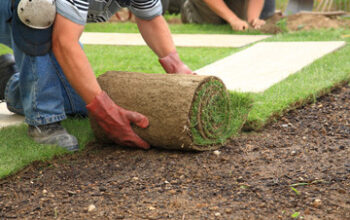Kentucky Landscaping adds beauty and value to homes. It also provides health benefits, such as increased air quality, reduced stress and a sense of well-being.
Consider the elements of balance, proportion and unity when creating your landscape. This includes a variety of plants and structures, and balancing repetition with new features.
The cost of landscaping depends on the complexity of the project. Generally, large projects will be more expensive than small ones. Some factors to consider include the location, the size of the garden, and the type of plant or material chosen. Another factor is the level of maintenance. In many cases, there will be a need for grading, grinding, and mulching. This will require heavy equipment and can add to the overall costs of the project.
Aside from aesthetic considerations, landscaping also enhances the function and value of a property. According to Virginia Tech, well-designed landscapes can increase a home’s value by up to 15%. However, it is important not to overdo the landscaping, as a poorly designed outdoor space can actually detract from a home’s value.
Landscaping is a highly skilled trade that requires professional expertise. The process includes a comprehensive terrain assessment and design planning to balance visual appeal and functional needs. It also involves the installation of structural elements, such as walkways, patios, water features, walls, and lighting.
Landscapers can help with a wide variety of residential and commercial projects. The most common are retaining walls, patios, and driveways. Landscaping can be very expensive, but it can also improve a home’s value and curb appeal. It can also provide a pleasant place for families and friends to gather and relax.
While the cost of landscaping varies widely, you can control some of the expenses by making smart choices and choosing affordable materials. For example, choose native plants to reduce maintenance costs and ensure proper watering. You can also install a drip irrigation system to minimize water usage.
For larger projects, the cost can range from a few hundred dollars for basic service to tens of thousands of dollars for more elaborate landscaping. In addition to labor, you’ll need to consider the cost of materials and equipment like a tractor and mower.
Creating a brand for your landscaping company can also add to the cost of your services. In addition to a memorable logo, you’ll need to invest in marketing tools such as email marketing and customer relationship management. These tools can help you cultivate new leads and sprout trust with existing clients.
Design
Landscape design is the process of arranging outdoor features to create a pleasing appearance. It involves choosing plants and structures that fit the local climate, soil conditions, and sun/moisture exposure. In addition, it considers the overall look and feel of a property and aims to create a balance between man-made and natural features. It can also help improve a home or commercial building’s energy efficiency. A well-designed garden can also provide a place for relaxation and exercise, as well as a habitat for local wildlife.
Landscapers can use a variety of techniques and materials to transform the outdoor environment. They can add curb appeal with colorful flowers and decorative shrubs, create a peaceful retreat with water features, or install functional outdoor living spaces. They can even increase a property’s value and offer a place for children and pets to play. However, the key to successful landscaping is planning. Professionals understand the importance of balancing aesthetics, functionality, and budgetary constraints.
Landscaping can be divided into two categories: softscaping and hardscaping. Softscaping refers to the planting of grass, trees, and other non-living elements, while hardscaping includes items like patios, walkways, and retaining walls. Softscaping is usually considered more artistic than hardscaping, but both are important aspects of a well-designed garden.
The most important aspect of landscape design is the selection of plants that are compatible with the local climate and soil conditions. Depending on the type of soil, a landscaper may need to amend it with organic material or even install drainage systems. They may also need to consider the size and location of existing buildings, and consider future growth when selecting plants.
Landscaping can also involve the construction of outdoor features such as pools, decks, and patios. In new construction, landscapers can work with architects to ensure that the outdoor environment is integrated into the overall design of the building. They can also install irrigation systems and lighting to reduce maintenance requirements and maximize the benefits of the outdoor space. Landscapers can also help with a variety of environmental issues, such as erosion control, stormwater management, and air quality improvement.
Maintenance
Landscaping adds beauty and value to a property, and regular maintenance is essential for its long-term health. It involves a wide range of activities, from lawn mowing to watering and fertilization. Proper maintenance also helps protect the environment and promotes wildlife habitat. It is important to choose plants and trees that are suited to your climate and soil conditions. You should also keep in mind that the appearance of your landscape changes with the seasons, requiring seasonal adjustments.
A professional landscaping company can help you achieve your goals and maintain the health of your outdoor spaces. They can design a custom layout, plan for plant growth, and install hardscaping and softscaping elements. They can also provide services for soil testing and analysis, irrigation system installation, and tree planting and care. These professionals can also help you create a maintenance schedule for your landscape.
Softscaping refers to the living components of your landscape, including flowers, shrubs, and grass. These elements give your garden depth and color. They can be accented with other features, such as fountains and ponds, that add sound and movement to the space. Water features also attract wildlife and serve as a source of oxygen.
Hardscaping includes nonliving structures like patios, walkways, and retaining walls. These can be made of a variety of materials, such as stone or wood. These elements can be used to define the boundaries of your outdoor space and create a sense of harmony and balance. They can also complement the architecture of your home and blend into the natural surroundings.
The most common maintenance tasks include mowing, trimming, and pruning. You should also check the condition of your mulch and make sure that the ground is free of weeds. The health of your trees and plants is also important, so you should regularly inspect them for pests, diseases, and damage. It is also a good idea to fertilize and water your plants, and if necessary, apply pesticides to protect them.
A well-maintained landscape increases the value of a property and makes it easier to use. In addition, it can reduce noise pollution and improve air quality. However, it is important to be aware of the costs associated with this type of work. You should consider all aspects of your budget and discuss them with a landscaper.
Environment
Landscaping involves a wide range of skills and techniques, from planting trees and shrubs to altering the terrain. It is a way to enhance the beauty of a property and add value to it. It can also provide a variety of environmental benefits, such as reducing soil erosion and providing habitats for wildlife. The practice has been around for centuries, with ancient civilizations modifying their environment to create gardens and agricultural systems. Today, many homeowners and businesses engage in landscaping to make their outdoor spaces more appealing.
Sustainable landscaping is a growing trend that involves using native plants and implementing water conservation measures. These measures can significantly reduce maintenance costs and lower the impact on the environment. For example, drip irrigation systems can help conserve water by delivering the right amount of water to plant roots. In addition, using rain barrels to collect rainwater can reduce reliance on municipal water supplies and reduce evaporation.
Other eco-friendly landscaping practices include using organic fertilizers and avoiding chemical pesticides. These practices are important for preserving the integrity of the soil and maintaining a healthy lawn. They can also help reduce greenhouse gas emissions and reduce the use of fossil fuels. Incorporating natural elements into the landscape, such as a pond or stream, can also help reduce the use of chemicals.
Landscapes that offer habitat for wildlife support biodiversity and ecological balance. They can also improve air quality and decrease noise pollution. However, they must be carefully designed to accommodate the different needs of wildlife. For example, a suburban landscape should include a mix of short and tall species to provide shelter for ground-dwelling and treetop birds.
In addition to reducing energy costs, sustainable landscapes can also help reduce the amount of waste produced by homes and businesses. They can reduce the amount of carbon dioxide and carbon monoxide released into the atmosphere, as well as lessen the need for artificial lighting and air conditioning. Incorporating water features into the landscape can also help reduce energy consumption, as can choosing energy-efficient light bulbs.
A well-designed landscape can increase the value of a home or business, and it can provide a place for people to relax and enjoy the outdoors. It can also provide many environmental and health benefits, including reducing soil erosion, improving air quality, and enhancing the visual appeal of the area.

